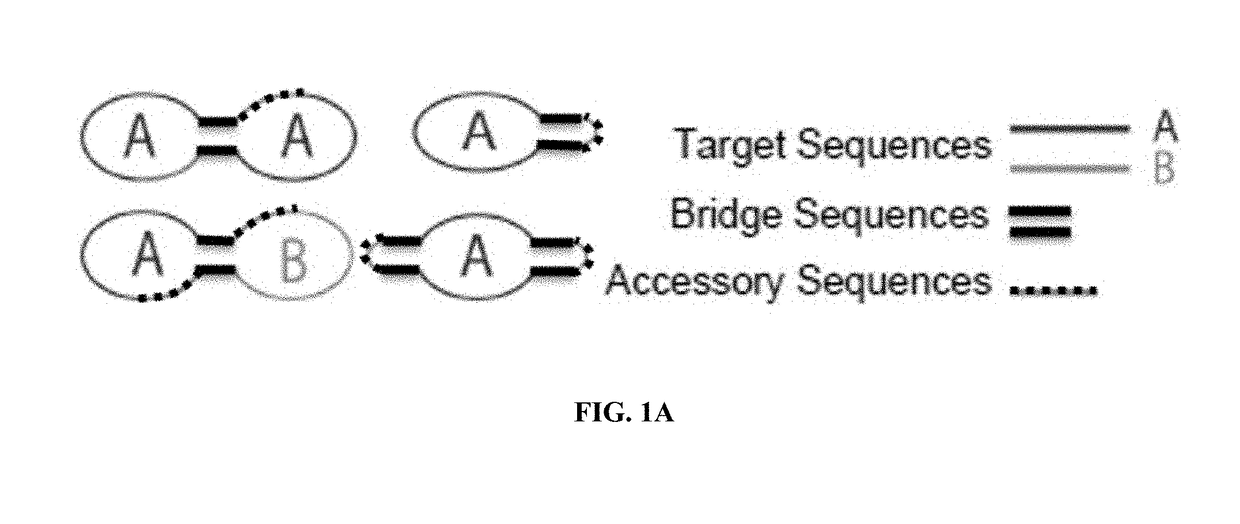Target reporter constructs and uses thereof
a reporter and target technology, applied in the field of molecular biology, can solve the problems of acute infection, unsatisfactory diagnostic analysis results, and inability to identify individuals with recent infections, and achieve the effect of facilitating the localization of replicated trcs
- Summary
- Abstract
- Description
- Claims
- Application Information
AI Technical Summary
Benefits of technology
Problems solved by technology
Method used
Image
Examples
example 1
Generation of TRCs
[0248]TRCs were constructed from single-stranded DNA oligonucleotides (Integrated DNA Technologies). The 5′ and 3′ ends of the oligonucleotides were strategically placed within the toehold or bridge sequences and slow cooling under high-salt conditions forced the 5′ and 3′ ends to sit adjacent and encouraged the correct intra-molecular ligation by T4 DNA ligase (New England Biolabs). Treatment with exonucleases I and III eliminate unligated reactants. Gel electrophoreses was used to confirm the correct size and purity of the final TRC population. Multiple TRCs were generated for each miRNA and the final miRNA-specific TRC (i.e., one TRC per miRNA target) was selected after empirical testing.
[0249]As a demonstration of feasibility, TRCs were designed and synthesized targeted toward miRNAs in the C. elegans let-7 family. let-7 family members are rigorously used to test miRNA platform specificity as they frequently differ by a single nucleotide. Here, two functional T...
example 2
TRC Analysis of Circulating Pancreatic Cancer miRNA Signatures
[0257]Pancreatic cancer (PaCa) is a fundamentally challenging malignancy to combat. Most cases are diagnosed in advanced stages with few effective medical options, and survival rates are abysmally low (5-20% over five years). Many recent studies have outlined the utility of miRNAs, and specifically cell-free miRNAs, in the course of PaCa for early detection and disease surveillance.
[0258]TRC platform functionality is demonstrated by targeting nine miRNA species that have been detected at elevated levels in the plasma of pancreatic cancer patients by currently available methods. These miRNAs include miR-10b, miR-21, miR-25, miR-106b, miR-155, miR-196a, miR-210, miR-212, and miR-221. The TRC platform is further validated by two sets of control TRCs to enable normalization across samples and confirm assay functionality including four miRNA targets present in the plasma of healthy humans miR-15b, miR-16, miR-24, miR-217 and t...
example 3
TRC Diagnostic Analysis of Oral Pathogenic Nucleic Acids
[0263]Multiplex pathogen detection of HIV, HSV-1, and EBV viral sequences is achieved by several TRC configurations (FIGS. 1A and 1E). TRCs are constructed from several ligated oligonucleotides under dilute conditions and complimentary junction-spanning RNA splints and SplintR Ligase, obtained from New England Biolabs, are added to encourage intra-molecular ligation. Multiple TRCs are generated specific for each pathogen, and these may be used singly or in combination.
[0264]To transform these target sequences into functional primers that may initiate rolling circle replication (RCR), the overhanging 3′-end sequences were removed up to the double-stranded complimentary region and present a 3′-OH group. This method, outlined in FIG. 1D, leverages the intrinsic 3′-exonuclease (3′-exo) activity exhibited by DNA polymerases or a separate standalone exonuclease. The inherent 3′-exo activity of φ29 DNA polymerase was shown to remove t...
PUM
| Property | Measurement | Unit |
|---|---|---|
| volumes | aaaaa | aaaaa |
| FWHM | aaaaa | aaaaa |
| temperature | aaaaa | aaaaa |
Abstract
Description
Claims
Application Information
 Login to View More
Login to View More - R&D
- Intellectual Property
- Life Sciences
- Materials
- Tech Scout
- Unparalleled Data Quality
- Higher Quality Content
- 60% Fewer Hallucinations
Browse by: Latest US Patents, China's latest patents, Technical Efficacy Thesaurus, Application Domain, Technology Topic, Popular Technical Reports.
© 2025 PatSnap. All rights reserved.Legal|Privacy policy|Modern Slavery Act Transparency Statement|Sitemap|About US| Contact US: help@patsnap.com



